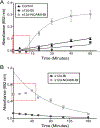Multivalent site-specific phage modification enhances the binding affinity of receptor ligands
- PMID: 25692462
- PMCID: PMC6252250
- DOI: 10.1021/acs.bioconjchem.5b00011
Multivalent site-specific phage modification enhances the binding affinity of receptor ligands
Abstract
High-throughput screening of combinatorial chemical libraries is a powerful approach for identifying targeted molecules. The display of combinatorial peptide libraries on the surface of bacteriophages offers a rapid, economical way to screen billions of peptides for specific binding properties and has impacted fields ranging from cancer to vaccine development. As a modification to this approach, we have previously created a system that enables site-specific insertion of selenocysteine (Sec) residues into peptides displayed pentavalently on M13 phage as pIII coat protein fusions. In this study, we show the utility of selectively derivatizing these Sec residues through the primary amine of small molecules that target a G protein-coupled receptor, the adenosine A1 receptor, leaving the other coat proteins, including the major coat protein pVIII, unmodified. We further demonstrate that modified Sec-phage with multivalent bound agonist binds to cells and elicits downstream signaling with orders of magnitude greater potency than that of unconjugated agonist. Our results provide proof of concept of a system that can create hybrid small molecule-containing peptide libraries and open up new possibilities for phage-drug therapies.
Conflict of interest statement
The authors declare no competing financial interest.
Figures





References
-
- Dente L, Vetriani C, Zucconi A, Pelicci G, Lanfrancone L, Pelicci PG, and Cesareni G (1997) Modified phage peptide libraries as a tool to study specificity of phosphorylation and recognition of tyrosine containing peptides. J. Mol. Biol 269, 694–703. - PubMed
-
- Tian F, Tsao ML, and Schultz PG (2004) A phage display system with unnatural amino acids. J. Am. Chem. Soc 126, 15962–15963. - PubMed
-
- Somers K, Stinissen P, and Somers V (2011) Citrulline-modified phage display: a novel high-throughput discovery approach for the identification of citrulline-containing ligands. Proteomics 11, 2550–2554. - PubMed
-
- Saleh L, and Noren CJ (2011) Site-directed chemical modification of phage particles. Phage Nanobiotechnol, 202–219.
-
- Barrett RW, Cwirla SE, Dower WJ, Gallop M, and Woiwode TF (2007) Compounds displayed on icosahedral phage and methods of using same, Patent WO 2002077182 A2.
Publication types
MeSH terms
Substances
Grants and funding
LinkOut - more resources
Full Text Sources
Other Literature Sources
Research Materials

